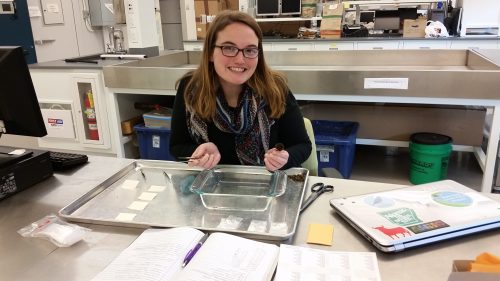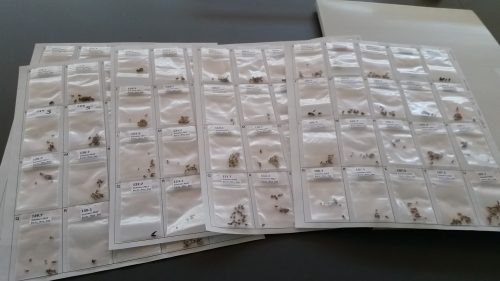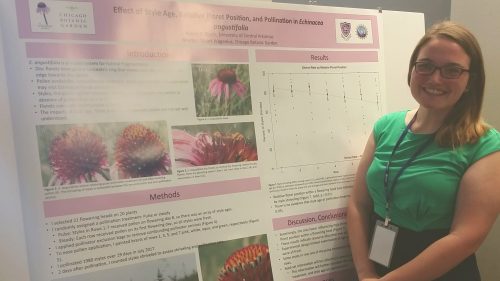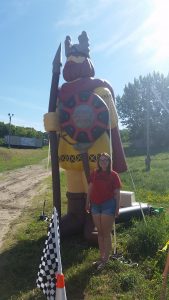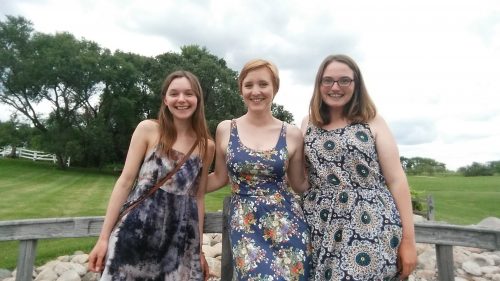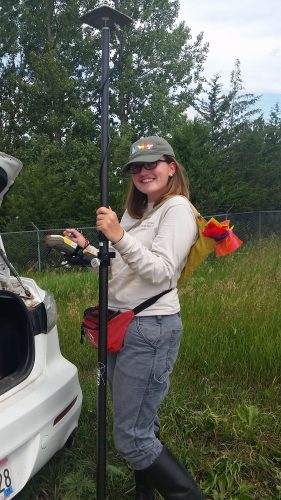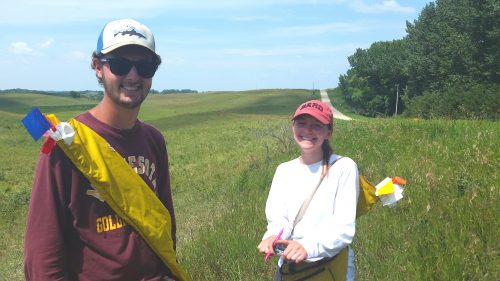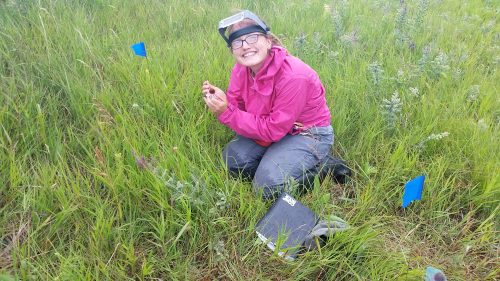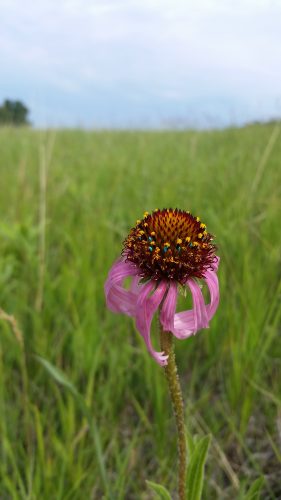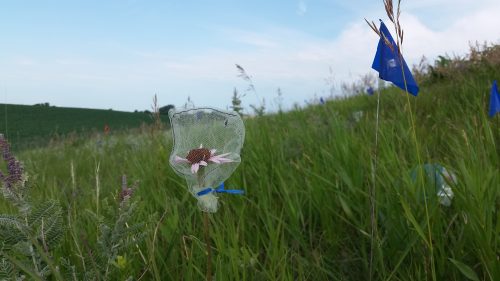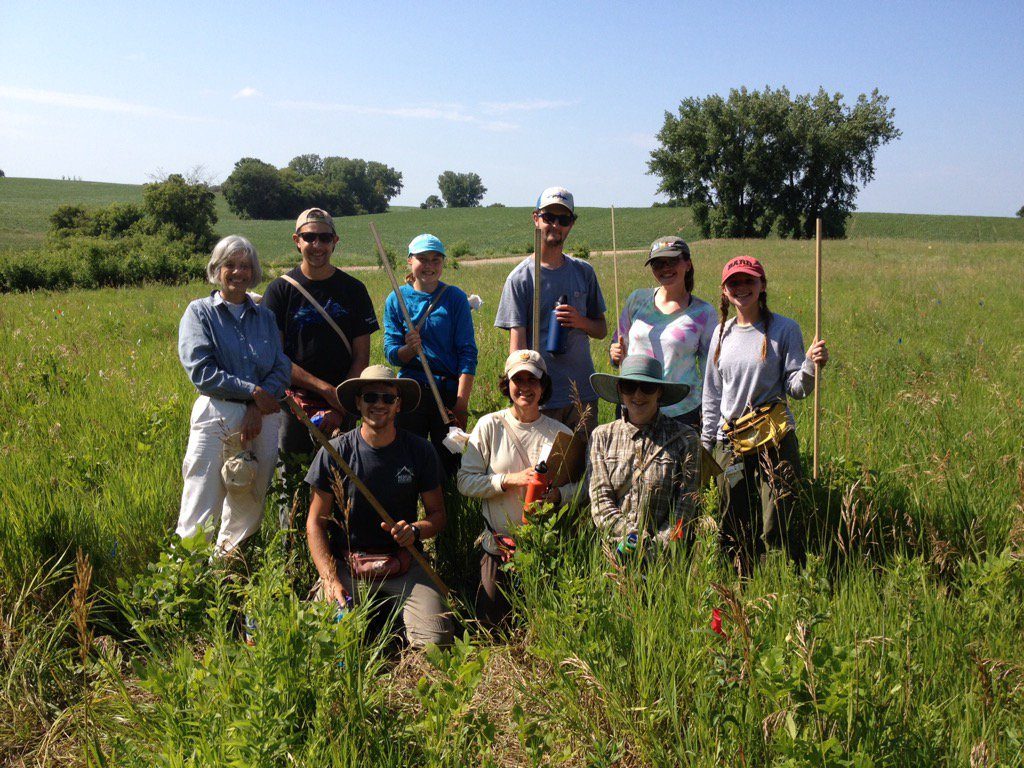|
|
Hi Flog following!
I’m excited to have worked in the Echinacea Project’s lab at the Chicago Botanic Garden for the past few days. While I was here, I worked on the seed set portion of my summer 2017 REU project (which I have now named Barto’s Nice Experiment), and I caught up with many friends from the field season. It’s definitely been a fun week for me in the Chicago area!
At the end of the summer, the team collected my experimental Echinacea heads from the Nice Island remnant in Minnesota after I left. When I came to the garden with Tracie on Thursday of last week, I began dissecting them. I started by separating all rows from each other, but I quickly realized I was only able to accurately distinguish the odd rows (which had painted bracts). To work efficiently, I categorized all achenes into 4 groups based on where they came from in each head: Row 1, Row 3, Row 5, Row 7, or Even Row. Between Thursday, Friday, and the first half of today, I cleaned my 21 experimental heads. Each of the odd rows were put into their own baggie and attached to an x-raying sheet. With the guidance of Tracie, I was able to capture images that show the fullness of all of my odd-row achenes. With this data, I can create a GLM in R like I did with my pollination data from the summer and model which experimental variables (row within the capitulum, style age, and pulse/steady pollination treatment) affected the seed set in my experiment.
For now, I am going to count the full/partially full/empty achenes in my x-rays and get ready to return to Arkansas tomorrow.
 Ashley working in the Echinacea Project lab at the Chicago Botanic Garden.  Setting up the achenes for x-raying! Each of the baggies here has one row’s worth of achenes.  Final x-ray product for one row of achenes.
Ashely Barto, an REU student in summer 2017, developed an independent project looking at how pollination influences reproductive success in Echinacea angustifolia. She was interested in how heads that get pollinated each day differ from heads that only get visited infrequently, but receive a lot of pollen on those sporadic visits.
Over 19 days in July 2017, 1980 styles from 21 capitula were pollinated following a randomly assigned pollination schedule: pulse or steady. Capitula assigned to the pulse pollination treatment received pollen on all emergent styles at the same time, so there was a range of style ages. Steady pollination capitula received pollen daily, so all styles were pollinated on the day they emerged. Style shriveling, a proxy for pollination, was used as the response variable.
Using a generalized linear model, interactions between style age, floret position, and pollination treatment were considered to create a pollination rate model. Style age and pollination treatment did not interact or have an additive effect on pollination rates. Instead, floret position within the capitulum was the only factor essential to modeling pollination rates in Echinacea. The results suggest resource allocation plays a major role in Echinacea reproduction. Ashley will investigate seed set from the same capitula later this year to further elucidate the role of style age, floret position, and pollination treatments in Echinacea reproduction.
 Echinacea on its third day flowering. Within the disc florets, there are persisting styles in Row 1 (A), fresh styles in Row 2 (B), and new anthers in Row 3 (C).
Ashley presented her work at the 2017 Arkansas INBRE Conference on October 28. Arkansas INBRE is the Arkansas Institutional Development Award’s network of biomedical research conference, and this year, it was hosted at the University of Arkansas. While this conference attracted undergraduates from many states to present on biomedical research in biology, chemistry, and physics, there were many posters like Ashley’s sharing summer research outside of the medical scope central to the conference’s theme. Ashley was able to talk about the Echinacea Project’s big picture work and how her independent REU Project fit into that larger image.
 Ashley presenting her summer REU project at the Arkansas INBRE Conference in October 2017. Start year: 2017
Location: Nice Island, prairie remnant
Physical specimens:
- 21 harvested Echinacea heads at the CBG, ready for cleaning and x-ray
Products: Here’s Ashley’s Poster of her results.
It’s my last day here at the Echinacea Project 2017. I learned so many new things and met many wonderful people during my time here, and I’m sad to see my time come to its conclusion. Nonetheless, we made the most of the day…or we tried to at least.
The team started the morning off doing re-checks in p1 while Stuart and I spoke about my experience and my project. He gave me some valuable tips for presenting my work, and I made it a goal to finish my project assessment within a week. Post-our meeting and morning re-checks, I headed out to p2 with Will and Wes to harvest. Sadly, many of the heads we harvested already shed many achenes, so we spent a large portion of our time at p2 picking up achenes from around the plant. For one head alone, we picked up 102 achenes! We decided since lunch time was approaching that we ought to head back and be sure to grab tweezers for the afternoon harvest work.
Lunch was filled with a fun discussion of peach-day calendars (again) and plans for the eclipse Monday. We intended to start work, but the rain persisted, so I gave a brief presentation to the group about my summer research project, and the whole team contributed valuable feedback to enhance my project. When I was finished, we had independent project time, so Tracie and Lea headed out to do vegetation analysis, Alex and Kristen worked on pinning, and I worked on creating maps for harvesting my Echinacea heads.
After work, we relaxed for a while and eventually went to the Douglas county fair where I savored fried Oreos and cheese curds while gazing at prize-winning cabbage as big as a globe.
Now, I’m all packed up and ready to leave first thing in the morning. It’s been real. It’s been fun. It’s been a real fun summer with the Echinacea Project–Definitely one for the books.
My time here as a 2017 summer team member of the Echinacea Project is nearing its end. During my REU internship, I have had the opportunity to work under great mentors and with some great peers, and I’m sad I only have one week left. Nonetheless, I hope to make the most of my last week, and the data analysis part of that week continued today. This morning, I worked on my generalized linear model of my shrivel rate data in R using a model problem Stuart gave me. Lea helped me work through some errors returned to me while creating my models, and she used her Solidago figures to help explain the difference in additive and multiplicative interactions. Tomorrow, I hope to find what is significant in my study using the
 Viking set-up at Andes GLM!
While I worked on my analysis, there was a mountain bike race at Andes, and part of the set-up included a 3 meter viking near the finish line. Taking a picture with it was somethings I definitely could not pass up.
In the afternoon, Lea, Tracie, and I enjoyed a evening celebrating a great summer. Since it’s my last weekend before returning to my university in Arkansas, we wanted to have a great evening, so we enjoyed a night out in Alexandria!
 Tracie, Lea, and I in Alexandria We are excited to welcome our new roommate, Kristen, tomorrow!
This summer, I’ve been working on an experiment examining style age, pollination treatment, and row position. For future members of Team Echinacea, I wanted to share my data with them. 🙂
To this post, I’ve attached two .csv files. “HeadData_081017” includes data applicable to each head as a unit, and “RowData_081017” includes data applicable to each row. I’ve also attached a .txt file titled “PlantRowShrivelData_MetaData_081017,” which gives an overview of my experiment and explains each column in my .csv files.
.csv files:
HeadData_081017
RowData_081017
.txt file:
PlantRowShrivelData_MetaData_081017
To read the .csv files, copy this script into R:
HeadData<-read.csv(url("https://echinaceaproject.org/wp-content/uploads/2017/08/HeadData_081017.csv"))
RowData<-read.csv(url("https://echinaceaproject.org/wp-content/uploads/2017/08/RowData_081017.csv"))
I spent my Sunday preparing for the week and relaxing.
Lea and I went grocery shopping in the morning, and when I returned to Andes, I started Swirl in R. Between lessons, I tinkered with my pulse and steady pollination data. By Tuesday, I hope to have some basic descriptive statistics to share with the team.
So far, using the range function, I was able to see my experimental plants’ styles emerged between July 8th and July 26th, and were pollinated within the same range. I was also able to see the sum of all the styles I pollinated: 1980! Hopefully, tomorrow I can work on finding the overall average style shrivel rate on day 1 and day 2 considering both treatments, and eventually, I hope to be able to find the shrivel rate by treatment in R. While I can find these things within the spreadsheet itself, I think R is a valuable tool I can use for my data analysis for this project, and it is a skill I need to develop as a young ecologist.
Other than working in R, I enjoyed listening to the cool rain that poured over Andes, and I savored Lea’s Beaufort stew dinner. A few of us also gathered around to stream some silly shows and share a laugh.
That’s all for this relaxing and somewhat productive Sunday.
Until next time, I’ll be sharpening my R skills!
Team Echinacea started the morning off with a brief meeting. Stuart reminded us of all of the neat things we’ve done since the field season commenced in mid June, and I must agree, we have done a lot! We have measured all of p8; we’re nearing the end of phenology; we’ve added and excluded hundreds of aphids; and we’ve just begun total demography. Not to forget the smaller individual projects we’ve undertaken, we took a moment to give a very short update on some of our projects’ progress. Our morning meeting transitioned to a new topic as we stalled, so some of the dew in p8 could evaporate: Anna is competing for the title of Queen of Waterama this weekend, and we shared our support for her and enthusiasm for the event. I’m excited to spend Saturday in Minnewaska!
Soon enough, we embarked on our morning task: assessing fitness in p1. I worked with Tracie, and we had fun while crawling through the rows and spotting Echinacea. We switched between recording and measuring, so we never got tired of either task. Tracie was the real star though: Towards noon, she coordinated Anna and I measuring, and she didn’t lose her place once in the Visor! Speaking from experience, that was a feat.
Over lunch, we talked about Waterama a bit more, and our conversation somehow evolved to include hitchhiking. After a few fun anecdotes and many bouts of laughter, we decided on our afternoon objectives. On his way to set out pan traps, Alex dropped me off at Nice Island to count shriveling rates on one of my plants. As I walked from the approach to my plants, I waved to Anna and Wes as they drove to Steven’s Approach to do demography. Then 10 minutes later, Will and Tracie picked me up to do demography at Around Landfill.
 Ready for PBORY! As I set up the GPS, Will, Tracie, and I decided I am standing Queen PBORY, as I love to stake with the GPS and therefore use PBORY frequently. We staked about 35 plants before the GPS went to float, and it remained on float for a solid 30 minutes. I walked as far away from the power lines and the electric fence to minimize interference, and that put me in the middle of the road. I was cautious of traffic flow as I waited for the GPS to return to fixed. After re-configuring the modem multiple times, we restarted the GPS and we were able to stake again–Crisis averted. Eventually, we finished the first portion of Around Landfill, and we picked up Wes and Gretel on our way back to the Hjelm House.
 Will and Tracie love PBORY, even when the GPS is floating We left a bit earlier than usual, so we could eat and get ready for our evening activity–Game night!
 Will, Tracie, and Alex ready to start a fun game of Pandemic! We started the evening off with some refreshing iced tea, and we selected the board games we wanted to play. I chose to play Pandemic with Alex, Tracie, and Will, and Wes, Gretel, Stuart, and Per started a game of Ticket to Ride. Soon, Amy and other members of her research team joined us at game night, and they joined in on Ticket to Ride just as our game got started.
While we played, we shared fun conversations, and even through times of disease outbreak, we kept our cool, and played our cards right. At one point, however, it seemed like the game was over, and the diseases were going to win. After an ice cream and rice crispy break however, we were reinvigorated to defeat the diseases and win the game. As Alex airlifted Tracie across continents, Will quarantined diseases in the East, and I stopped cascading outbreaks in their tracks in the South, we slowly but surely saved the fictional world of Pandemic from doom and won the game.
Overall, and especially after saving the world, I would call today a success (and a lot of fun)!
Good afternoon, Flog readers!
As an REU intern and member of Team Echinacea, I get to do an independent research project of my choice. I’m excited to be studying the effect of style age, resource allocation, and pulse pollination on Echinacea angustifolia. I’ve attached my research proposal for your enjoyment and others’ future reference.
I’m excited to conduct this study!
My proposal: BARTO_Proposal_2017
 Bracts of rows 1, 3, and 5 painted.  Pollinating Echinacea
It’s phenology Wednesday, and you know what that means! Team Echinacea headed out to our experimental and remnant sites to assess Echinacea phenology. Will and I took the Around Land Fill Loop, while the other teams tackled p2, Staffanson, and our other remnants.
On phenology days, I collect pollen as I collect data because my personal project requires ample pollen. That doesn’t mean the pollen is abundant, however. Today, while I found anthers with copious pollen at Around Land Fill, I had to battle ants off of the Echinacea heads, and to collect data, I often had to wait for ants and other critters to walk to the ray florets, away from the immature florets I needed to count. Collecting what I believed to be enough pollen wasn’t an issue once I had shooed the critters, and Will and I headed back to the Hjelm house to check p1 by 11:00.
About two-thirds of the way through collecting data in p1, I saw raindrops smearing my check marks on the clipboard. Will suggested we get our rain jackets from inside, and we started to head back, but we stopped to look at a few more heads. Then, Stuart advised us to go in, and thunder clapped. About 15 minutes later than everyone else, Tracie and Anna came in from Staffanson. To our dismay, Tracie had lost her phone at Staffanson, and the rain was incessant, meaning immediate recovery was delayed. While rain poured over the research base, lightening flashed, and thunder shook our chairs, Tracie and other team members strategist a way to recover her phone. The solution: a systematic search of the area where she last saw her phone. We ate lunch, visited with Amy and her student, and headed out to Staffanson to find Tracie’s phone. We searched for about 10 minutes; then, Tracie found her phone! Woohoo!
 Tracie moments after recovering her phone at Staffanson Because the search took a lot less time than we anticipated, Tracie helped me with my afternoon task of counting, pollinating, and painting my experimental plants. Pollination was going steady for the first 40 minutes, but then the rain set in, and my pollen started to clump, and I used a lot of the remaining pollen on a few styles. Half way through one of my pulse treatments, I ran out! Without much trouble however, Tracie and I drove to a nearby remnant to collect the rest of the pollen I needed, the rain let up, and I was able to finish my daily pollination.
After our field day, we came home and got ready for dinner: wing night at Angelina’s! We shared lively conversation, and met up with another research team in the area for cookies and socialization.
In the style of our new Twitter page @echinacea_rates, I give today a 12/10 for turning itself in a great direction.
Happy Tuesday, Flog readers!
Team Echinacea took the morning to work on personal projects, so I hitched a ride to my experimental site, Nice Island. There, I collected pollen and made notes about what my plants were up to. Since I’m examining each row of Echinacea florets under different pollen treatments, I am generally quite careful to note strange things. Today, I noticed one of my plants had styles that were wilted and discolored, another had a severely tilted receptacle, and another was turning crispy–Yikes! I talked to Stuart, and I will remove those from my experiment later this week. Bummer. 🙁
 One of my experimental plants after I painted R5! Fortunately, the ones that are becoming obviously unfit for my experiment are few and far between, and I’m finding more suitable candidates.
I spent most of my time this morning bagging capitula, pollinating styles, and painting bracts to denote rows. It’s a detailed-oriented task, no doubt, but it has required me to channel my inner artist to meticulously paint the small bracts. I really enjoy doing it too. I can put on some music, sing along, and paint at the tempo of the song. It’s great.
When I counted, pollinated, and painted all that I needed to for the day, I started back on my walk to the Hjelm House. To my surprise, Ruth met me at Nice Island, and I happily showed her what I was up to, and she asked some key questions about my project. She also showed me a magnifying visor I can wear while I do my crosses, and I think it will be very useful in the future, so I can be sure I am using enough pollen on each style.
 One of my experimental plants with a pollinator exclusion bag. When Ruth and I returned, I had about an hour before lunch to organize my data from the day. I’ve created a colorful spreadsheet to remind me of what color each row is painted and when each head needs to be pollinated. As I count shriveled styles in my steady pollination treatment and enter that data, my spreadsheet updates the percent of shriveled styles–a key metric for my experiment. I like how my experiment is shaping up!
When lunch came, I enjoyed my egg, hummus, and apple meal while the team talked about rating Echinacea and why Team Pallida isn’t quite the antihero to Team Angustifolia. Pleasant conversation, for sure. When lunch wrapped up, Ruth shared some tasty almond chocolate with all of us, and we marveled at the Romeo & Juliet excerpt on one chocolate’s wrapper and the Bubo bubo information on the other’s wrapper.
In our post-chocolate contentedness, Ruth talked to us about the Echinacea fitness experiment in p1, Gretel talked to us about the protocol for measuring that fitness. After our introduction to the experiment, we booted up (although some chose to tough it out in sandals), and headed out to p1. We measured for a couple hours, and by the time we wrapped up our field time for the day, we were nearly 2/3 done with that experiment’s measurement!
 The team after an afternoon of measuring in p1 When the Andes crew returned to our summer home, we removed our ticks and battled mosquitoes. For dinner, I made artichoke and spinach stuffed shells and a salad from the lettuce in our weekly CSA. Yum yum!
Now, I’m going to try to plan out a pollination schedule, so I can try to go on the orchid trip Thursday.
Until next time,
Ashley
|
|
